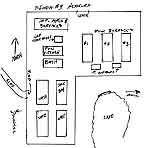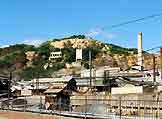| Sendai
#3-B Hosokura, Miyagi (also known as Uguisuzawa) |
Camp List Main Index
|
Location: MIYAGI-ken, KURIHARA-gun, UGUISUSAWA-mura [Uguisuzawa] Short History: 1 Dec 1944: Established as Tokyo 3-B 28 Jan 1945: Approx 250 Americans, 50 British and 3 civilians arrive ex Camp layout (3rd location at Ohashi Theater from Aug. 15 to Sept. 12, 1945)Camp layout (3rd location at Ohashi Theater from Aug. 15 to Sept. 12, 1945)Camp layout (3rd location at Ohashi Theater from Aug. 15 to Sept. 12, 1945)Enoshima Maru ex Taiwan 14 Apr 1945: Jurisdictional control transferred from TOKYO POW CAMP (3-B) to SENDAI POW CAMP. Established as Sendai 3-B. 12 Sept 1945: Rescue effected Satellite view Aerial (1947; courtesy of Japan Map Archives) Japanese Staff: Lt. Katsuo Ishizawa - Camp Commander Sgt. Tasobei Chonan - somewhat lenient Sgt. Kunpei Shimizu Lt. Koiwa - interpreter Yunosuke Iwabuchi - guard Camp Layout: 
Camp
Buildings: Books: Gaskill, Robert C., Guests of the Son of Heaven, New York, 1976; camp doctor Tony Czerwein, POW Tears That Never Dry, Publisher: Library Research Associates Inc (1994) Harry Franz, Bamboo Treadmill (online book) |
Overview: Hosokura mine was owned and operated by Mitsubishi Mining Co, (MITSUBISHI KOGYO HOSOKURA KOZAN) during WWII. Enslaved by Mitsubishi were 231 American POWs and 3 civilian Americans plus some 50 British who were forced to mine and produce lead and zinc. The mine was closed in 1987 and is now a theme park (Hosokura Mine Park) where visitors can walk through its major tunnel. Here and there are life-size mannequins of mine workers. (attached photo) There are explanation boards throughout the tunnel, but the wartime use of Allied POWs or Korean workers is never mentioned. (Mine Entrance- 2003) - Images courtesy of Kinue Tokudome A memorial plaque has been placed at the camp site by Mitsubishi Materials (see below). Short History of Arrival: Departing Moji by train, about a dozen men were removed in Osaka area for hospitalization. Upon arrival in Sendai, changed to a narrow gage railway high into the mountains. From the Uguisuzawa RR Station, the men were required to walk last few miles through deep snow. Hellships: Enoshima Maru from Taiwan Most Americans had earlier been taken to Taiwan on the Hokusen Maru Rescue Video: View this unedited motion picture of the rescue at this camp (425Mb MP4 file), along with interviews of four men -- Zimmerman, Aubuchon, Benini, Gaskill. On-screen counter:
NOTE: This video is no longer available on the website due to size constraints. It is now available for viewing here. Let us know if you would like the full video.01:02 ~ 02:21 Sendai Camp #4 scenes (9/11/45) 02:22 ~ 08:59 Sendai Camp #3 scenes (9/12/45) 09:00 ~ 11:12 Gen. Wedemeyer arrival at Nanking air field 11:13 ~ 12:21 Japanese soldiers embarking on ship 12:22 ~ 13:29 "Japs being disarmed" 13:30 ~ 14:11 Japanese leaving camp 14:12 ~ 14:33 Omori camp 14:34 ~ 16:29 "Yokohama Prison" and "war criminals" (10/5/45) 16:30 ~ 17:40 "Stockade #2, Omori POW Camp" Video player counter: Interviews with sound 17:00 Zimmerman 19:45 Aubuchon 22:52 Benini 25:18 ~ 26:00 Gaskill Total length of film = 27:46 (last 2 min. blank) Rosters: Total: 281 POWs (234 American, 45 British, 2 Dutch; 19 deaths) Americans (with one possible Dutch) British All men arrived January 1945 on the Ennoshima Maru via Formosa and Moji. Mr. Louis B. Read submitted a partial roster and Ernest Bales submitted the Chaplain's roster. Download Roster Spreadsheet (xls); contains additional information. Roster Aug. 15, 1945 (RG 389 Box 2070) Liberation roster with NOK (RG 389 Box 2071) - US, British, Dutch Ross Report: Describes trip to the camp from departure in Manila Affidavit: Alonzo C. Meredith's story from capture on Corregidor until rescue in 1945. Memoir: Alonzo C. Meredith's story entitled "A Long Trip". Relates story of hell ship, work on Taiwan and Sendai #3. Rescue: Three (3) POWS killed by air drops of food. Rescue effected 15 Sept 45. One British (Ward, D.) and two Americans, Carl Burk Gann and Orrin E. Crandell, 45.8.22. One American (Anderson) died on a rescue ship en route home. Henry Farr deposition (JPG, courtesy of Teancum Keele) - CPNAB employee, was working on constructing tunnels for Navy on Corregidor when captured (Note: reported to Les Schwab, Master Mechanic, on Bataan). |
|
Memorial Plaque
 In Memory of WWII POWs
During World War II, military personnel of the Allied Forces captured by the Japanese military were forced to work in mines and factories throughout Japan. These included the Osarizawa (Hanawa) Branch of the Sendai POW Camp that was under the control of the Japanese military and located at this site. In all, 545 POWs (494 American, 50 British, and 1 Australian) were held at the camp at the end of the war, 8 POWs died in captivity. Working conditions for the POWs were exceedingly harsh and left deep mental and physical wounds that the lapse of time would not heal. POWs were subjected to similar conditions in the mines of Hosokura (Miyagi Prefecture), Ikuno (Hyogo Prefecture) and Akenobe (Hyogo Prefecture), which were also operated by the former Mitsubishi Mining Company. Reflecting on these tragic past events with the deepest sense of remorse, Mitsubishi Materials offers its heartfelt apologies to all former POWs who were forced to work under appalling conditions in the mines of the former Mitsubishi Mining Company, and reaffirms its unswerving resolve to contribute to the creation of a world in which fundamental human rights and justice are fully guaranteed. November 2016
Mitsubishi Materials Corporation Article from July 2015 re Mitsubishi Materials Corp.: "Japanese Company Apologizes to POWs" |
|

